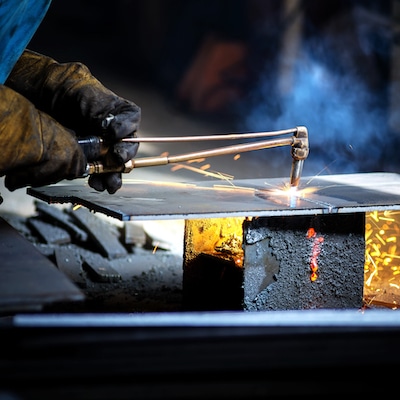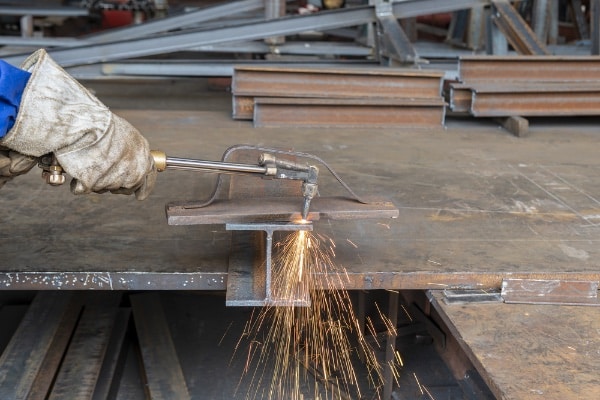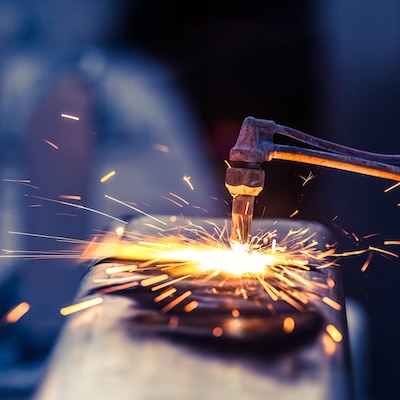Gas Cutting Torch Safety Tips

Gas cutting torches are incredibly versatile welding, cutting, and bending tools. They are also highly dangerous, whether you are using them as welding equipment or for cutting operations.
Rigorous adherence to the safe operation of a cutting torch is vital to avoid severe injuries or deaths. Any improper use can spell disaster – learn more below. (We also have a full welding training video that you should check out as well.)
Characteristics of Acetylene Gas
Inhaling acetylene causes neurological, cardiovascular, and pulmonary symptoms and possibly death.
This gas is volatile, auto-ignites under pressure, and violently decomposes if pressurized above 15 psi; work with pressures between 3 and 7 psi.
Acetylene cylinders contain porous filler and liquid acetone to dissolve the acetylene. Do not keep cylinders horizontal; this disrupts the stability of this system.

Characteristics of Oxygen
This gas is an accelerant, meaning that it causes flammable materials to burn hotter and faster, even explosively. Ignition with acetylene produces a flame of up to 6,300°F, making rigorous safety measures vital.
An oxygen cylinder contains oxygen compressed to around 2,300 psi. Never allow one to fall over: damage to the valve turns it into a devastating projectile due to the internal pressure.
What PPE Is Required When Using Cutting Torch?
Don appropriate personal protective equipment (PPE) before working with an oxy-fuel cutting torch.
That means a breathing mask with a HEPA filter and ANSI-approved eye protection; the tinted lens should be at least a #6 rating.
Wear heavy-duty leather gloves, a leather apron, a hard helmet, steel-toed work boots, and a long-sleeved jacket and pants over a cotton underlayer (e.g., jeans and a t-shirt).
Inappropriate Clothing with Personal Protective Equipment
Never wear synthetic fibers (or synthetic mix), as heat and sparks cause them to melt and burn into the skin. Keep your clothes free of acetylene, oil, grease, and oxygen: you don’t want them to become highly flammable!
Any onlookers should also wear PPE.
Safety of Work Area
Work in a well-ventilated area, and do not smoke (or allow anyone else to smoke) while using an oxy-fuel cutting torch!
Ensure that any combustible materials (wood, plastic, petrochemicals such as oil and grease) are at least 35 feet away or covered with flame-proof guards. Avoid cutting or welding containers that hold flammable materials.
Keep an appropriately-sized ABC fire extinguisher close at hand.

What Are the Safety Precautions in Gas Cutting?
Clear understanding is essential; always refer to the manufacturer’s instructions. Repair or replace damaged equipment; do not use it! You might also want to take a look at our welding safety checklist which has some good tips for any welder or metal worker.
Oxy-Fuel Equipment
Ensuring oxy-acetylene cutting torch safety begins with comprehending each piece of oxy-fuel equipment:
- Cylinders
- Regulators
- Hoses
- Check valves
- Flashback arrestors
- Cutting torch
- Heating tips
Handling Cylinders
Always store, transport, and use acetylene cylinders upright, handle them gently, and secure them against falling.
If an acetylene cylinder has been kept horizontally, carefully bring it upright, and do not use it until it has been vertical for as many minutes as it was horizontal.
Inspect the fuse plugs every time you do cutting or welding. Do not use the cylinder if they are loose and any acetone has leaked. Please do not attempt to refill it; return it to the authorized gas distributor.
Store fuel gas and oxygen cylinders 25 feet apart or separate cylinders by a barrier at least five feet high and rated to resist fire for at least 30 minutes. Do not store them near heat sources or flames.
When storing or moving cylinders, remove the regulator and cap them.

Safe Use of Regulators
Never apply oil or grease to either regulator or any other piece of gas-cutting equipment. Pure oxygen plus petroleum products results in spontaneous combustion.
Use the appropriate regulator for the gas in question, and do not interchange the regulator between cylinders. Handle any regulator gently.
Purge the cylinder valves of dirt before attaching the regulator by briefly opening first one cylinder, then the other; do not use compressed air. Check the adjusting screw first.
Open the oxygen cylinder valve slowly to avoid straining the regulator, and stand to one side!
Safety of Hoses
Oxygen hoses are green (or black), corresponding with the color of the oxygen cylinder (the coupling has a right-hand thread).
Fuel gas hoses are red, again corresponding with the cylinder (the coupling has a left-hand thread). Do not do this work if you are color-blind!
Do not allow hoses to kink. Protect them against sparks and sharp edges. Use soapy water to detect any damage before beginning gas cutting or welding.
Install check valves on the hoses to prevent the backflow of gas and flashback arrestors from preventing flames from burning back to the cylinders. Some flashback arrestors incorporate check valves.
Bear in mind that these safety devices are not a substitute for the correct operation of the cutting torch.

Oxy-Fuel Cutting Torch Safety
The cutting torch is the most dangerous piece of equipment in the system because the gases used in oxy-acetylene work mix here. Gases and fumes, according to OSHA, pose a real danger to users of cutting torches and other welding equipment. So what are the safety precautions in cutting operations?
Ensure the torch is free of oil and grease, and clean the tip before use.
When working with acetylene, open the valve on the acetylene cylinder first, to a maximum of 0.75 turns, and ignite it with friction lighters (not a cigarette lighter or match).
Back out the regulator to avoid too much pressure on it. The flame begins orange, with black smoke – increase the acetylene to reduce the smoke.
Open the oxygen valve completely so the flame becomes bluish-white and the inner, cone-shaped flame reaches the tip (the so-called neutral flame).
While cutting or welding, keep the valve wrench in place. Always point the tip away from people. Do not lay down a lighted torch or walk around with it!
Follow manufacturer instructions when shutting off the flame. Generally, you should kill the accelerant before the fuel (at the torch). Then completely shut each cylinder valve.
Finally, reopen the torch valves to bleed off gases in the hoses. Do not purge both gases simultaneously!
Preventing Backfires and Flashbacks
Use the correct tip size and pressure – follow the manufacturer’s instructions. Too low pressure or contacting the work surface with the tip causes a backfire.
Whistling or hissing after a backfire indicates a flashback: gas flow draws flame back down either hose to the cylinders, causing an explosion.
Flashback arrestors halt flashbacks: they are not optional equipment. Too much pressure causes reverse flow; check valves to stop this process.

Acetylene Fuel Gas and Alternate Fuel Gases
There are other oxy-fuel processes you can use. Alternate oxy-fuel cutting gases burn much cooler than acetylene.
When working with these fuels, turn both the fuel and the accelerant on before lighting. When shutting down, cut the fuel first.
What Precautions Should You Take When Using a Gas Welding Torch?
These gas cutting-torch safety tips are designed to keep you and your employees safe and sound when using highly dangerous equipment. From proper training on dangerous chemicals to the correct PPE, every precaution must be taken.
Work carefully, not hastily. If in doubt, slow down and think!